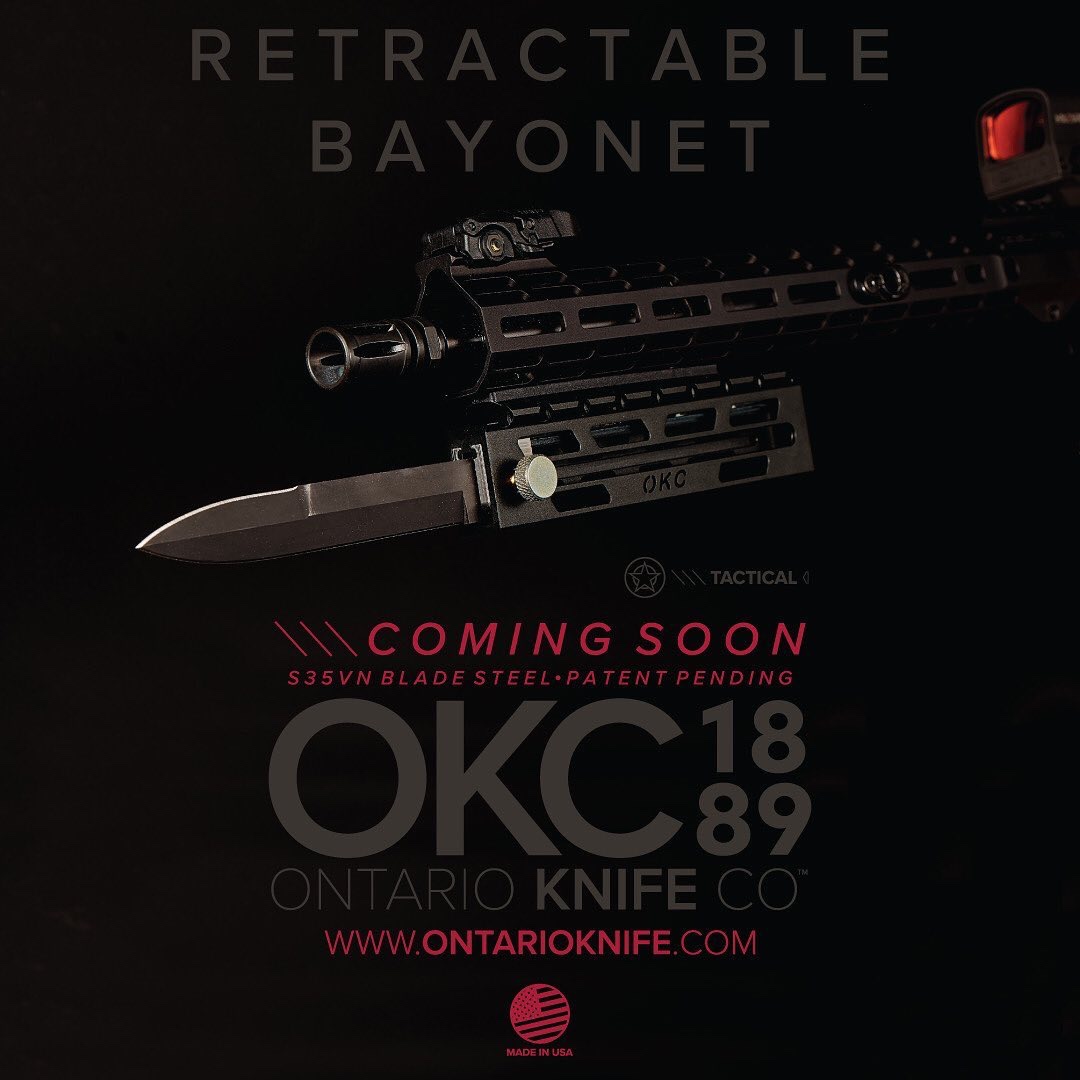While Ontario Knife Co isn’t the only company who has developed a bayonet, it looks like they’ll be the first to market.

The OKC Retractable Bayonet attaches to your AR, or any firearm outfitted with a Picatinny Rail System. Featuring a 6-inch retractable blade crafted with high quality .1875”-thick S35VN steel (with blade hardened to 59 Rockwell C), the bayonet measures 13-inches in open position, and 7-inches when closed. With simple one-handed operation, the bayonet deploys with a quick pull of its spring-loaded, stainless steel knob. This same knob can be used to easily retract the blade back into its carriage when not in use. With multiple mounting options, the blade can be positioned forward or further back on the firearm to custom fit the barrel, and the user’s preference to how much blade is exposed beyond the barrel. The multi-functional blade can also be taken off the firearm and used as a regular knife.
The OKC Retractable Bayonet has a 6-inch long by 1.5-inch-wide housing constructed from 6061-T6 aluminum with a black anodized finish.


“If they are close enough to stick…they are close enough to shoot!” said the grizzled veteran as he stopped the new replacement from fixing his bayonet. Extra points for anyone else who knows what obscure WWII movie that quote comes from. If I was going to add the weight of a blade to the end of my weapon I think I would at least want a good sized Swiss Army Knife or Leatherman instead. Much more useful in real life.
I did see a bayonet draw blood once. The old EIB test had a grenade throw task lane. It involved jumping into a series of fighting positions (3 in all, if I remember correctly). Once in each hole you had a chance to throw up to two grenades into a one meter circle near a tire / e-type silhouette ~30 feet away.
When the grenade went off, the EIB candidate would run from the hole, bayonet the tire, and move to the next hole and repeat the process. I was waiting for my turn in the holding area with a couple of other guys. Suddenly there was a lot of screaming and all the lane graders ran into the woods.
A couple of minutes later two of them came out practically carrying a solder between them. He was a bloody mess from his forehead to his belt and was moaning in pain. I looked at one of the other guys and he blurted out what we were all thinking. “Christ, you have to fight somebody who knows his shit at the end!”
Turned out the kid had stumbled as he got out of the foxhole and stabbed himself in the lips. I understand that it took a lot of stiches to fix and that he basically ate through a straw for several weeks.
I went on to pass that lane and get my EIB but I learned a couple of things that day. One, even a relatively minor wound to the face will bleed a lot. And two, it is safer to shoot em then stab em.
TLB
Always enjoy reading your wisdom sir. Your conclusion parallels John B. George’s experiences in the Pacific Theater; that at bayonet engagement distances, the pistol was superior. That being said, besides use as an ancillary weapon, a well designed bayonet is not without merit: Fixed blades excel at fieldcraft/survival, a well executed integral wire-cutter can be useful for engineers*, usage as an expedient mine probe, EPW control, makeshift hammer, etc. On the plus side, in today’s risk adverse military**, a bayonet seems almost innocuous in comparison to a pistol. However, I will say this OKC product seems to be a gimmick.
*From hearsay gerbers suck at cutting c-wire.
**Gun-free zones
Guest,
Absolutely agree. I never went anywhere without a good fixed blade knife. Everything from the old fashioned Kabar to a Randall to an Ek and finally the Yarbrough.
I can’t speak to the Army issue Gerber wirecutters. I will say that the M9 Bayonet – as a wirecutter – leaves much to be desired. When they were first issued to the 82nd in the late 80s I personally broke two of them.
They did ok with the softer barbed wire. However, when I tried them on harder razor wire the lug that served as the attachment point on the scabbard broke off. As far as I know, that flaw wan not corrected on later versions.
There are better albeit more expensive options, but the M9 is not too bad as a field knife. If you carry it, I would suggest making it lighter by removing the wirecutting attachment on the scabbard and the sharpening stone if you have one of the older versions.
If your mission calls for any serious amount of wirecutting get yourself a real wirecutter for that task.
TLB
P.S.
BTW, when I reported the defect with the M9 scabbard the first response was to make out a statement of charges because I had “destroyed government property.” However, since the bayonet did not come with any caveats about what kind of wire it could be used on, I pointed out that I was using it IAW it’s designed purpose. In the end, I was told to stop trying to cut razor wire with the M9 and there would not be a problem!
Actually, the M9 is a better field knife than it is a bayonet. The older M7, which has a blade profile similar to this OKC retractable example (above), is much better for thrusting and just as good for slashing. Of course, the very characteristics that make the M7 a good bayonet mean that it isn’t much of a field knife. Ultimately, that is the M9’s problem. It is fundamentally a compromise that tried to be too many things – field knife, bayonet, wirecutter – and still it would not be my first choice for any of those functions.
TLB